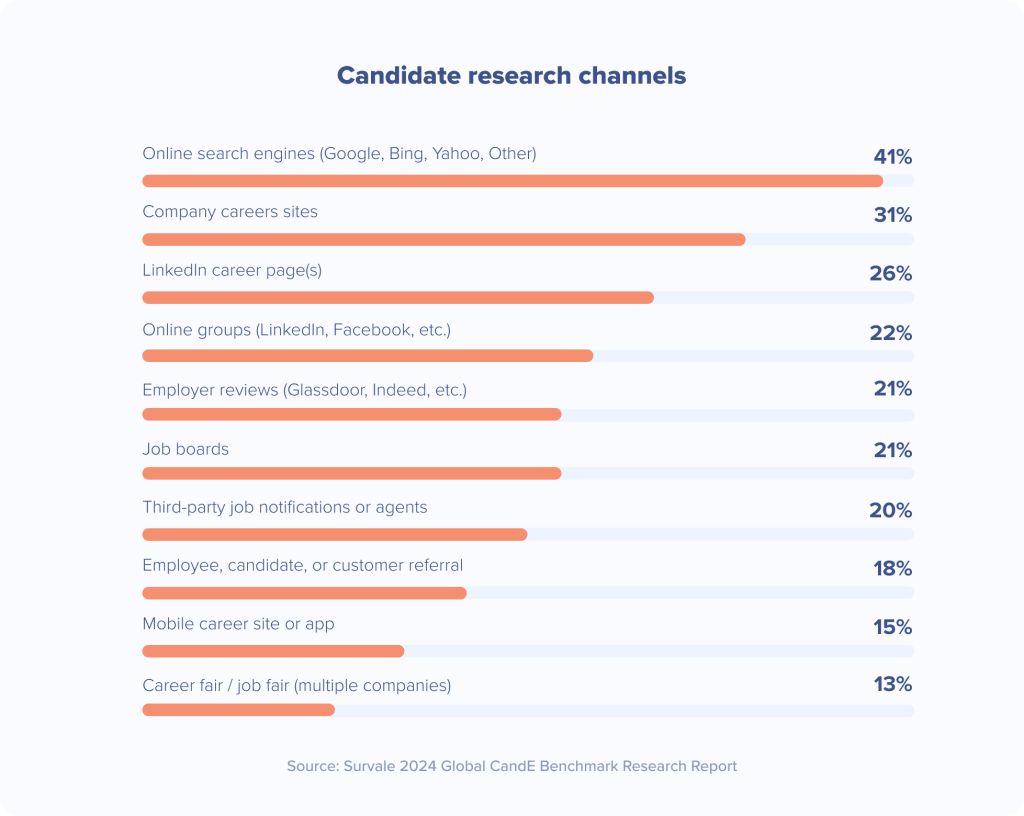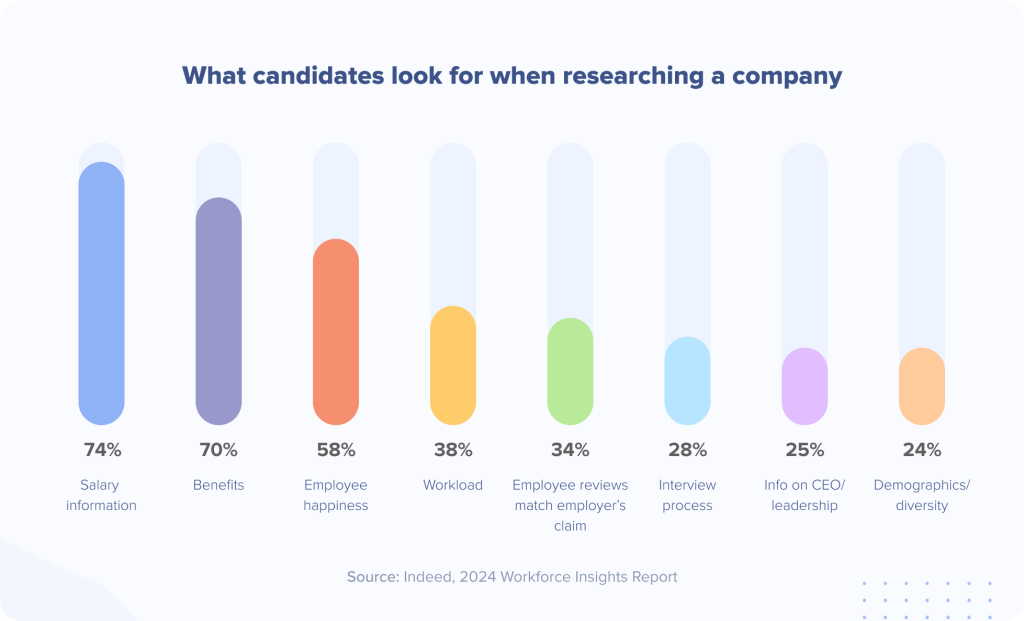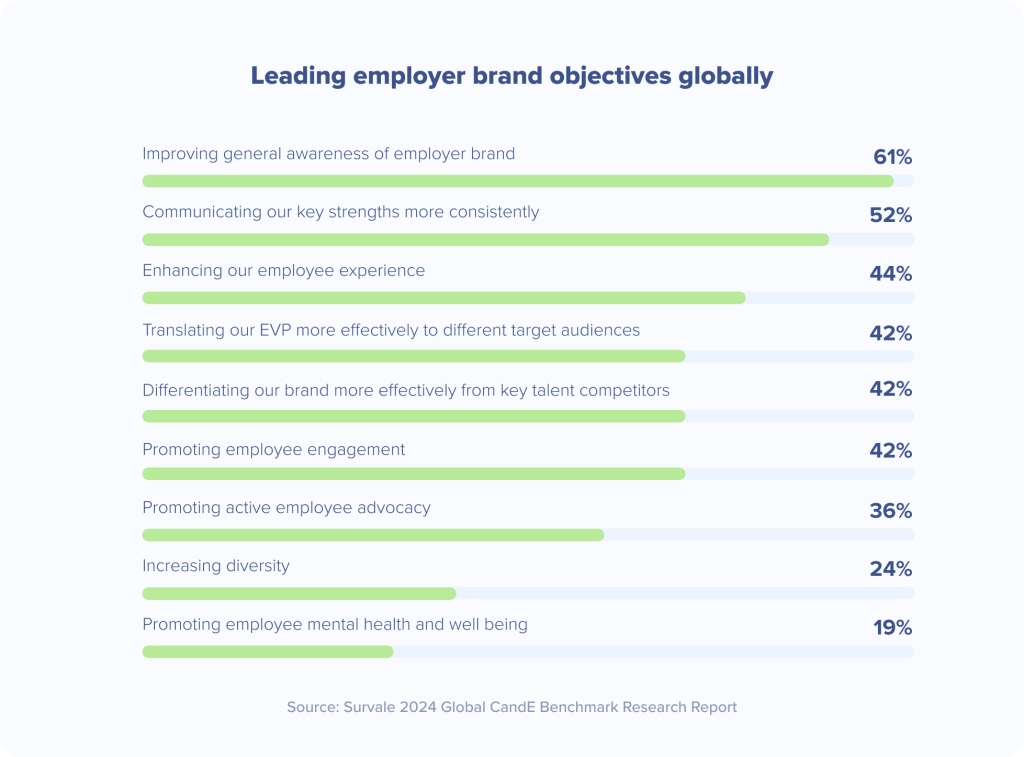
Subscribe for updates
Get talent acquisition best practices, trends, and news delivered directly to your inbox.
By entering your email, you agree to receive marketing emails from JobScore
Two-thirds of HR leaders globally say the labor shortage is getting worse. Candidates — especially those with the most in-demand skill sets — have choices about where they want to work. They research your company before applying, read reviews from current and former team members, and compare your culture against that of your competitors. A strong employer brand helps you attract more qualified candidates faster, but a weak one can send qualified talent straight to your competition.
Let’s explore the latest employer branding statistics that reveal the state of employer branding, why it matters, and what your team can do to stand out.
Companies that improved their Glassdoor rating by 0.5 points saw 20% more job clicks
Small improvements in your employer rating can widen the top of your talent funnel. Companies that boosted their overall rating by just half a star experienced 20% more clicks on their job postings and 16% more application starts on average. That’s a substantial lift.
Employer ratings directly influence whether candidates even look at your open positions. Many job seekers filter by rating when browsing opportunities, automatically excluding companies below a certain threshold. A higher rating also signals credibility — it’s social proof that people generally have positive experiences at your organization.
Improving your rating requires addressing the root causes of negative reviews rather than just gaming the system. Respond to reviews: 71% of Glassdoor users say their perception of a company improves when employers take the time to reply. Survey your team members to understand their concerns. Take action on the feedback you receive. Encourage satisfied team members to share their perspectives on review sites. Authentic improvement shows in your rating over time and, more importantly, in your ability to attract talent.
54% of candidates research every company before applying
Discerning candidates aren’t applying blindly: More than half of job seekers do their homework before submitting an application. Conducting an online search is the most common way candidates are learning more about potential employers, followed by careers sites and LinkedIn.

Employer branding isn’t just about attracting candidates, it’s about converting them into applicants. Candidates will simply move on to the next opportunity if they don’t like what they learn about your organization.
Make sure your online presence accurately reflects who you are as an employer. Monitor your employer brand presence across digital channels to ensure it highlights the things that make your team unique. Keep your careers site updated with current information about benefits, culture, and opportunities. Share authentic content that gives candidates a real sense of what it’s like to work at your organization. The time you invest in your digital employer brand pays dividends by attracting candidates who are already interested and informed.
74% of candidates are looking for pay rages
Candidates want to know what they can expect if they join your organization. They most commonly look for information around your compensation package, company culture, and hiring process to assess whether your opportunity is a good fit. Salary information is the most common thing job seekers look for when deciding whether to pursue an opportunity, though certainly not the only one. Employee happiness and workload also rank highly.

This data reveals a clear hierarchy of candidate priorities. Provide the information candidates want so you can attract and convert those who are genuinely interested and qualified — but be authentic. Some candidates are willing to take a lower salary if it means they’ll have better work-life balance, but others may not. Being upfront with job seekers enables them to self-select, saving everyone time in the long run.
Only 17% of candidates believe employers are very honest in how they present their brand
Candidates seek authenticity but don’t feel they’re getting it. Fewer than two in ten job seekers believe that employers are very honest when presenting their employer brand. This credibility gap undermines even your best recruiting efforts.
Many job seekers have seen firsthand how organizations overpromise and underdeliver. Job descriptions often paint unrealistic pictures and career sites showcase only highlight reels, leading candidates to discount what they read. Your claims carry less weight than reviews from team members and candidates.
Building authenticity takes consistent effort. Share real stories from current team members, including challenges they’ve overcome. Acknowledge areas where you’re working to improve. Respond thoughtfully to negative reviews rather than defending or deflecting. Offering transparency — even around your imperfections — can make candidates more likely to trust what you say about the positives.
87% of U.S. job seekers say reputation influenced their decision to take their current role
Your employer brand is a key deciding factor for candidates. An overwhelming majority of American workers consider a company’s reputation when deciding whether to accept a job offer.
Work takes up such a significant portion of your team members’ day and they don’t take employment decisions lightly. In-demand talent, in particular, know they have many other opportunities available to them and may rather wait for a better fit. A poor employer brand can cost you a top-choice candidate and extend your hiring process as you continue with other candidates.
Use your job offer letter to highlight what’s in it for the candidate if they join your team, including information about your compensation, benefits, and company culture. Let the candidate know you’re available to answer any questions that come up.
14% of job seekers didn’t show up for their first day after finding negative information
Indeed’s research found that 14% of candidates who accepted job offers never showed up for day one because they discovered negative information about the company. That’s one in seven new hires walking away at the last minute.
This no-show rate represents a massive waste of recruiting resources. You’ve already invested time screening, interviewing, negotiating, and onboarding. Candidate ghosting often means you have to begin again from scratch.
Stay in touch with candidates between the time they accept your offer and officially start work. You can start introducing them to team members, share benefits information, and even get onboarding going — all before their first day.
80% of executive teams and 90% of HR professionals view employer branding as a priority
The importance of employer branding is clear — and company leaders are on board. Four out of five executives and nine out of 10 HR professionals consider employer branding a priority for their organizations.
Company leaders primarily want to focus on improving general awareness of their employer brand and communicating key strengths more consistently.

Only 26% of team members would recommend their organization as a great place to work
Your current team members are your most powerful recruiting tool — or your biggest obstacle. Just over one in four team members would recommend their organization as a great place to work. That means roughly three out of four wouldn’t actively endorse you to potential candidates.
Word of mouth carries considerable weight in today’s job market. Candidates trust what team members say far more than what your career page claims. Unenthusiastic team members can lead you to lose credibility before candidates even apply.
The good news is that you can change this. Start by measuring team member satisfaction regularly and addressing the issues they raise. When people feel heard and valued, they naturally become brand ambassadors. Focus on the fundamentals: fair compensation, growth opportunities, and managers who actually support their teams. This should carry through to your team member’s last days: Employees who have a positive exit experience are 2.9 times more likely to recommend their organization to others than are those who have neutral or negative experiences.
HR owns employer branding in 58% of organizations
HR owns employer branding in 58% of companies and another 24% share ownership jointly between HR and marketing or communications teams. This means that HR plays a central or shared role in shaping the employer brand for more than four out of five organizations.
The most effective employer branding efforts involve cross-functional collaboration. HR brings recruiting expertise, candidate insights, and employee relations. Marketing may contribute messaging, storytelling skills, and brand management experience. But most importantly, your company leaders influence what your team members think about your organization — and whether they’ll recommend it as a great place to work. You’ll create a more cohesive and authentic employer brand when these teams work together.
If your organization hasn’t clarified who owns employer branding, start that conversation now. Clear ownership with defined collaboration points ensures nothing falls through the cracks.
Final thoughts on these employer branding statistics
These employer branding statistics reveal both the challenges and opportunities ahead. Many organizations struggle with employer branding fundamentals and it’s costing them time, money, and access to skilled talent. But small improvements in how you treat people yield measurable results.
Your employer brand is shaped by what current and former team members say about you, what candidates experience when they interact with you, and how you show up online. Take the time to monitor your brand, address issues, and promote the things that make your team and organization unique.



